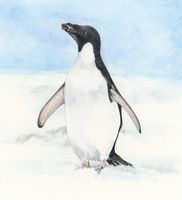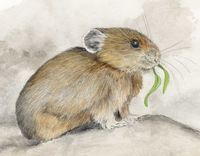
Sockeye Salmon
Latin name: Oncorhynchus Nerka,Conservsation status: least concern (population is stable)
Sockeye Salmon, once they leave the fresh water where they are born, may travel as far away as 2600 miles before returning to the same waters to spawn, one to four years later.
For decades wild salmon populations have been in decline from human causes: over fishing; habitat degradation—logging, mining, agriculture and dams; pollution; and interaction with hatchery or farmed salmon. These conditions and threats may hinder their ability to adapt to the effects of climate change. Salmon thrive at specific freshwater temperatures—warming air raises water temperature. Early snow melt and increased rains cause physical changes to spawning streams.
Other animals effected by climate change
 Koala
KoalaKoalas live in the woodlands of Australia. Thick fur and skin make it difficult for them to adapt to rising temperatures. Increased CO2 in the air produces less protein in the eucalyptus leaves, forcing the Koala to search for other sources of food and, in times of high heat, water. On the ground, the slow moving Koalas are prey to wild dingoes and domestic dogs, or are hit by cars as they cross roads. Their habitats are also being destroyed by drought, bush fires and development.
 Adelie Penguin
Adelie PenguinIn winter, the sun doesn't rise south of the Antarctic Circle. If Antarctic sea ice decreases and does not extend far enough to the north, Adélie Penguins, during their winter migration, may not be able to reach the sunlight needed to navigate, hunt and avoid predators—they won't dive in the dark. Other threats are oil pollution, fishing and disturbance of colonies from research stations and aircraft.
 American Pika
American PikaAmerican pikas occupy talus—rock piles that accumulate at the base of a slope—at high elevations in western mountains. Pikas are thought to be a prime example of the potential effects of climate change because they are sensitive to warm temperatures and rely on insulation provided by snow to survive cold winter temperatures. However, several recent studies indicate that pikas can be resilient to each of these factors. Most pikas in the Sierra Nevada survived the winter of 2014, when there was almost no snowpack. Pikas persist in many hot localities as well, demonstrating their ability to cope with high temperatures.
 Monarch Butterfly
Monarch ButterflyThe annual North American migration of the Monarch is listed as a "threatened phenomenon." Climate related threats include: drought, storms, changes in precipitation and dependence on temperature to trigger migration and reproduction. The Monarch feeds and lays eggs exclusively on milkweed plants, so it is also highly vulnerable to herbicides and habitat destruction.
